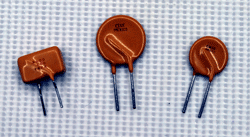When it comes to selecting a component to protect a circuit or equipment, a fuse will probably make it to the top of your list. This for a good reason. It is cheap, and does reliably what it is expected to do. But fuse suffers with at least a couple of annoying disadvantages: it can only do its job once, and has this habit of blowing at a time when you need the equipment most and do not have a spare fuse in hand.
I could imagine this occurring too often to Raychem engineers, and that what must have drove them to invent a self resetting fuse and reusable fuse, the now known Polymer Positive Temperature Coefficient PPTC Resettable Fuse.
A Resettable fuse is a protection component that breaks open, just like an ordinary fuse, when a current overloading occurs. But there the similarity ends. The Resettable fuse heals itself and, when the fault condition is removed, it will immediately spring back into life the next time you switch ON the affected equipment.
Calling the PPTC a Resettable fuse is somewhat of a misnomer. Self-Resetting fuse would have been more appropriate. But the given name stuck, so we will call it a Resettable Fuse just like every one else does.
NTC and PTC Thermistors
There is a special kind of resistor made so that its resistance changes in proportion to a temperature change. This component is the thermistor. Two general types are available. If the resistance increases with increasing temperature, the thermistor is called a positive temperature coefficient PTC thermistor. If the resistance changes towards the opposite direction, it is a negative temperature coefficient NTC thermistor.
NTC types exhibits linear resistance change over a limited temperature range. This characteristic makes the NTC thermistors useful as a sensor for temperature control (like thermostat control in air conditioning) and measurement applications (digital thermometer). Low resistance NTC thermistors are also widely in use as in-rush current limiter in power supply circuits.
PTC types, on the other hand, reacts to temperature changes in highly nonlinear way. There is a cold region in which large temperature change hardly causes any resistance change, but past a certain temperature (tripping point), resistance will increase at a rapid rate. PPTC thermistors are special types processed so that its resistance climbs up even faster when tripped. This is the basis of the operation of the PPTC Resettable Fuse.
How the PPTC Works
This is how the PPTC resetable fuse works in a circuit. When current flows though it, an internal heating occurs because of the I^2*R drop introduced by the component. If the current is low and the internal heating is not enough, nothing much happens. Current continues to flow undisturbed.
But with sufficiently large current, the PPTC is heated enough to reach its tripping temperature, and this is where a lot of things starts to happen. The PPTC resistance will suddenly rise, causing the current to drop. With appreciable resistance now introduced inside the PPTC, internal power dissipation shots up. This heats up the PPTC even more, causing its resistance to rise up even further. This regenerative action continues until the resistance increase reduced the current so low that no further increase in internal heating can occur. Circuit current, now greatly reduced (to an amount no longer capable of causing additional damage), will remain low until the circuit fault is removed.
If the fault is temporary (e.g. caused by another protection circuit such as over voltage crowbar protection circuit), the affected equipment can return back to service by merely turning it OFF and then ON again (power cycling).
Resistance vs Temperature plot of a PPTC device will look like as shown in the figure . Past the trip current, the resulting increase in temperature will cause an exponential increase in resistance.
Things to Consider
- PPTC is affected by ambient temperature. Tripping current shifts to a lower value as the ambient temperature is increased. Tripping current shown in data sheets are typical when measured on an ambient temperature of 20C (some may specify it at 25C).
- PPTC has a maximum operating voltage limit. Make sure the voltage ratings of the PPTC you use exceeds the maximum voltage of the circuit it will be connected with.
- A residual current will continue to flow after the PPTC “trips open”. The residual current is much lower that the trip current, and is inversely proportional to the applied voltage (i.e., the PPTC acts like a constant power device, keeping the I*V product constant).












0 comments:
Post a Comment